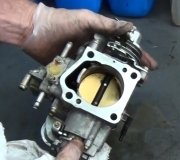When I'm driving in general, the car seems to hesitate a lot upon acceleration. I have to really press on the gas pedal to get the car to speed up. When it does, I notice that the RPM is at 2000 and it doesn't gain torque. I also notice the speed increasing at a slow rate, but it does speed up. The best way I can describe what I am feeling is the car is trying to struggle through a pool of thick molases. Very restricting.
As I accelerate for a couple minutes to gain speed and then let go of the gas pedal, I notice the RPM drop rapidly to about 1000RPM and then slowly raise up to 1500-1600 RPM. I really feel a hesitation when trying to accelerate any higher than 2000RPM. I can feel the speed increasing very slowly, but I don't feel the downshifting kick that you would usually feel when trying to go faster.
Also when the car coasts, it feels like it starts to slow down very rapidly on its own. You can feel the car slow down without even stepping on the break pedal.I can feel myself kinda lean forward as if I am stepping on the break. The break pedal feels kinda heavier than usual too.
At the same time all this is happening, I notice the steering wheel becoming harder to stear, the gas pedal suddenly needs more force to press down, and the suspension ride feels as if I have a cow or something on top my car and is putting a bunch of weight on the vehicle.
Here's the tricky part of all this.I have no CEL whatsoever and the car never feels like it’s going to stall at all! When I’m at a dead stop, the car idles smoothly. I don't know if this means that I don't have any error codes though. Would the CEL come on 100% of the time if there is an issue? Transmission fluid is new and there are no leaks or burning from the transmission. Spark plugs are new, air filter is new, but I don’t know about the fuel filter. The car has 80,400 miles on it, so I doubt it ever got changed before...
My gas mileage has gone to crap too! I filled up my tank with 91 octane gas. I’ve driven two 60-mile round trips to work, and I’ve already blown half a tank of gas! This is getting ridiculous and no Honda-specialized mechanic can figure the problem! What the hell!
I have experienced this with a Nissan Frontier as well and couldn't get it looked at before I traded it in for this Honda, so I never knew what caused all this. I am hoping that someone can help me with this. The Honda dealership techs continue to tell me that there is nothing wrong with the feel, and I know there is. Please help!
SPONSORED LINKS
Friday, September 23rd, 2011 AT 9:41 PM




